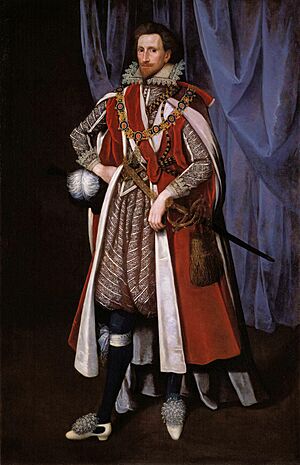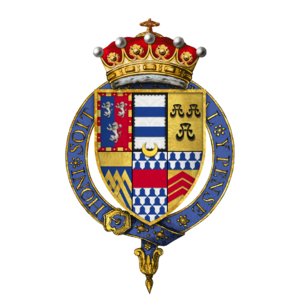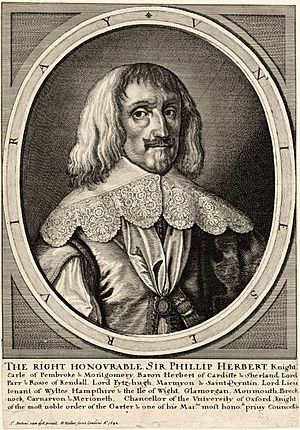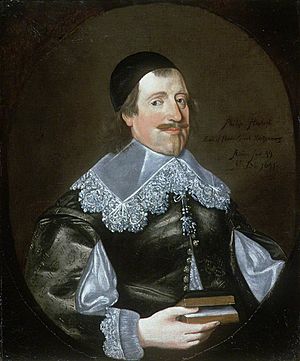Philip Herbert, 4th Earl of Pembroke facts for kids
Quick facts for kids
The Earl of Pembroke and Montgomery
|
|
|---|---|
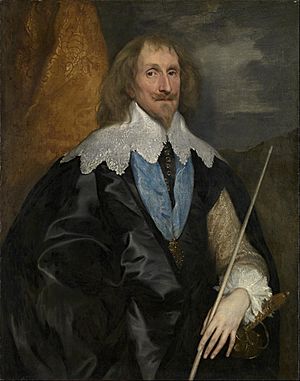
Portrait by Anthony van Dyck
|
|
| Born | 10 October 1584 Wilton House, Wiltshire, England |
| Died | 23 January 1650 (aged 65) Palace of Whitehall, London, England |
| Buried | Salisbury Cathedral |
| Noble family | Herbert |
| Spouse(s) | Susan de Vere Lady Anne Clifford |
| Issue |
|
| Father | Henry Herbert, 2nd Earl of Pembroke |
| Mother | Mary Sidney |
Philip Herbert, 4th Earl of Pembroke and 1st Earl of Montgomery (born October 10, 1584 – died January 23, 1650) was an important English nobleman and politician. He lived during the reigns of King James I and King Charles I. Philip married Susan de Vere, who was the youngest daughter of Edward de Vere, 17th Earl of Oxford. Philip and his older brother, William, were the "incomparable pair of brethren" to whom William Shakespeare's famous collection of plays, the First Folio, was dedicated in 1623.
Contents
Early Life and Royal Favor
Growing Up and Meeting the King
Philip Herbert was born at Wilton House, a grand family home. His father was Henry Herbert, 2nd Earl of Pembroke, and his mother was Mary Sidney. Mary was the sister of the famous poet, Sir Philip Sidney, and Philip was named after him.
When he was nine years old in 1593, Philip went to study at New College, Oxford. However, he only stayed there for a few months.
In 1600, at age 16, Philip first appeared at the royal court. When James I became king in 1603, Philip quickly caught his attention. Philip loved hunting and hawking, and these hobbies helped him become friends with the king. In May 1603, King James made Philip a gentleman of the privy chamber. This was a special role close to the king.
Marriage and New Titles
On January 1, 1604, Philip and his brother William performed in a play called The Masque of Indian and China Knights. This was at Hampton Court. Later that year, on December 27, 1604, Philip married Susan de Vere. King James I was very excited about this marriage. He even played a big part in the ceremony and gave generous gifts to the bride.
King James continued to give Philip many honors. In 1605, Philip became a gentleman of the bedchamber. This was an even closer role to the king. He was also given new titles: Baron Herbert of Shurland and Earl of Montgomery. The king also arranged for Philip to receive a Master of Arts degree from Oxford.
Philip enjoyed tournaments and court masques. He also liked to play games, which sometimes led to large debts. King James often helped him pay these off. In 1608, Philip became a Knight of the Garter, a very high honor. He was also made the high steward of Oxford in 1615.
Quarrels and Colonial Ventures
Philip was known for getting into arguments. In 1610, he had a disagreement with Henry Wriothesley, 3rd Earl of Southampton after a game of tennis. King James stepped in to help them make up. In 1617, he had another quarrel with Lord Howard de Walden. Even though he sometimes had these disputes, the King always forgave him.
Philip was also very interested in England's new efforts to set up colonies in other parts of the world. He joined several companies that were involved in these ventures. He became part of the council for the Virginia Company in 1612. He also helped start the Northwest Passage Company in 1612 and joined the Honourable East India Company in 1614.
More honors came his way during King James's reign. He became the keeper of the Palace of Westminster and St. James's Park in 1617. In 1624, he became Lord Lieutenant of Kent. Finally, in December 1624, he joined the privy council, a group of the king's closest advisors.
Life Under King Charles I
Continuing Royal Favor
When Charles I became king in 1625, Philip continued to be a favorite. He was part of the group that brought Queen Henrietta Maria from Paris to England. He also held the spurs during Charles's coronation in 1626. After his older brother died, Philip took over his role as Lord Chamberlain, a very important position in the royal household. In 1628, he was made Lord Lieutenant of Buckinghamshire.
Philip remained interested in colonial projects. In 1626, he helped start the Guiana Company. In 1628, he was given control over the islands of Trinidad, Tobago, and Barbados.
Philip's first wife, Susan, passed away in 1629. In 1630, he married again to Lady Anne Clifford. She was the daughter of George Clifford, 3rd Earl of Cumberland.
Becoming Earl of Pembroke
When his older brother died in 1630, Philip inherited the title of Earl of Pembroke. He also took on several of his brother's other important roles. These included Lord Lieutenant of Somerset and Lord Lieutenant of Cornwall. He was also appointed as the high steward of the Duchy of Cornwall and Lord Warden of the Stannaries.
Philip had a very large household. He had 80 staff members at his London home and over 150 at Wilton House. Wilton House was his family's main home in Wiltshire. Throughout the 1630s, King Charles I visited Wilton House every year for hunting trips. Philip was encouraged by the King to rebuild Wilton House in a grand style.
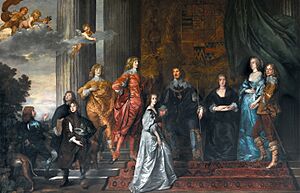
Supporting Arts and Literature
Philip loved art and collected many paintings. He was a supporter of the famous painter Anthony van Dyck. King Charles I also loved art, and in 1637, when the Pope sent many paintings to Charles, Philip was one of the few people invited to help open the cases. Philip also helped his page, Richard Gibson, become a successful artist.
Philip was also a big supporter of writers. Over forty books were dedicated to him during his lifetime. The most famous dedication was for Shakespeare's first folio, which was dedicated to Philip and his older brother. Philip also supported the writers Philip Massinger and his relative George Herbert. In 1630, he even helped George Herbert get a special church job in Wiltshire.
Disagreements with King Charles I
Religious Differences
Even though Philip and King Charles shared a love for art, they had different ideas about religion. Philip preferred a simpler form of Protestantism, which was similar to what Puritans believed. This caused problems with Queen Henrietta Maria, who was Roman Catholic. Philip also disagreed with William Laud, who became Archbishop of Canterbury in 1633.
Because of his religious views, Philip was sympathetic to the Covenanters in Scotland. These were groups who wanted to protect their form of Protestantism. Philip wanted peace during the Bishops' Wars between England and Scotland. He helped King Charles in talks with the Scots. Some Scots even thought Philip secretly supported their side. Philip, however, always said he was loyal to Charles.
Political Influence and Break with the King
Philip owned a lot of land, which gave him great influence in elections for Parliament. Many members of the House of Commons owed their positions to his support.
In 1641, Philip voted to punish Thomas Wentworth, 1st Earl of Strafford, a close advisor to the King. King Charles became very angry when Philip seemed to encourage a crowd that was against Strafford. The Queen urged Charles to remove Philip from his job as Lord Chamberlain. The reason given was another one of Philip's arguments. This time, he hit another nobleman with a cane during a meeting. Charles demanded Philip's resignation and replaced him. This event marked Philip's final break with King Charles.
Role in the English Civil War
Choosing Sides
When the First English Civil War began, Philip sided with the Parliamentarians. However, he was always one of the more moderate members of their group.
Parliament often sent Philip to negotiate with King Charles. At first, Philip still kept in touch with the King's supporters and said he was loyal to Charles. But in July 1642, he became one of five noblemen on the English Committee of Safety. This committee was set up by Parliament. In August 1642, he accepted the job of Governor of the Isle of Wight from Parliament. In 1645, Parliament made Philip Lord Lieutenant of Somerset and even voted to make him a duke.
Philip represented Parliament during talks with the King in Oxford in January 1643. He was also present during the Treaty of Uxbridge in 1645, another attempt at peace.
Supporting Religious Reform
As a supporter of religious reform, Philip was appointed to the Westminster Assembly in 1643. This was a group that discussed how to reform the church. Philip supported the moderate group that wanted to keep bishops, but he was strongly against other groups who wanted different church structures. He voted to punish Archbishop Laud in 1645.
During the political changes of the 1640s, Philip was first linked with a group of lords who supported the Self-denying Ordinance. This led to the creation of the New Model Army in 1645. However, by mid-1646, Philip started to disagree with this group. He wanted the New Model Army to be sent home right away. When there were riots in London in July 1647 against the army, Philip refused to join the lords who left the city to join the army. But in August, when the New Model Army marched into London, Philip quickly changed his mind. He claimed he had been forced to act before and had always supported the army.
Reforming Oxford University
After Archbishop Laud was arrested in 1641, the University of Oxford chose Philip to replace him as chancellor. When the King's forces took Oxford, they removed Philip. But after Parliament took Oxford, they put Philip back as chancellor in 1647. He was ordered to reform the university. Philip traveled to Oxford and oversaw the changes, ending resistance to the reforms.
End of Life
Final Years and Death
Philip believed that the King was important for any agreement between the King and Parliament. He strongly disagreed with the idea of not negotiating with the King in 1647–1648. In July 1648, Philip voted that James Hamilton, 1st Duke of Hamilton was a traitor for leading Scottish forces into England. He also wanted royalists who helped Hamilton to be declared traitors. In July 1648, Philip again negotiated with the King as part of the Treaty of Newport.
These talks ended suddenly in December 1648. After this, Philip and other Parliament members who were negotiating with the King told the army that they still supported them. However, they still wanted to make a deal with the King. In late December 1648, Philip joined a group that suggested a deal where Charles would lose some of his power.
The army did not accept the proposal, but they still wanted to have good relations with Philip. They soon agreed to let Parliament name Philip Constable of Windsor Castle. This made him essentially the King's jailer. In January 1649, Philip was appointed to the court that was set up to try King Charles I for high treason. Philip refused to take part in the trial, but he agreed not to speak out against executing the King.
In February, after the King was executed, Parliament appointed Philip to the English Council of State. Since the House of Lords had been removed, Philip had to run for election to Parliament. He was elected as a member for Berkshire in April 1649.
In May 1649, Philip became ill and stayed in bed for the rest of the year. He passed away in his rooms in Whitehall, Westminster, on January 23, 1650.
Philip's body was prepared and taken to Salisbury to be buried in Salisbury Cathedral. The English Council of State ordered all members of Parliament to go with his funeral procession for a few miles as it left London.
Family and Children
Philip Herbert first married Lady Susan de Vere (1587–1628/1629). She was the daughter of Edward de Vere, 17th Earl of Oxford. They had seven sons and three daughters, including:
- Lady Anne Sophia Herbert, who married Robert Dormer, 1st Earl of Carnarvon.
- Sir Charles Herbert, Lord Herbert of Shurland (around 1619–1635). He married Lady Mary Villiers but had no children.
- Philip Herbert, 5th Earl of Pembroke (around 1621–1669).
- Hon. James Herbert (around 1623–1677).
- Hon. Henry Herbert, who died young.
Philip Herbert married a second time to Lady Anne Clifford (1590–1676) on June 1, 1630. She was the daughter of George Clifford, 3rd Earl of Cumberland and the widow of Richard Sackville, 3rd Earl of Dorset. They did not have any children together.
Images for kids
-
Lady Susan's statue at Westminster Abbey on her mother's tomb.


